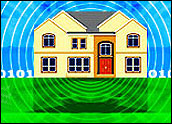
By now many of us — even some of us who once couldn’t program the clock in the VCR — have installed a WiFi router somewhere in our homes to use a laptop on the front porch or in the back den. If you fall in this group, congratulations. Whether you know it or not, you have joined the home network revolution.
Of course, for some consumers, the revolution begins and ends with that WiFi connection. A growing number, however, have dabbled in some of the Web 2.0 entertainment technologies and services that are being introduced almost on a daily basis, starting with streaming videos from service providers such as Netflix to, well, anything that can make use of a high speed Internet connection or signal — from radios that stream music to DVD players that allow you to watch YouTube videos on your TV. Even more have taken advantage of low-cost VoIP services — some of which have become sophisticated enough for business use.
Few consumers, though, have embraced the raison d’etre of home networking: home monitoring and remote energy management. People who live in a digitally networked home, for example, could watch the same movie on a computer or TV or smartphone in whatever room they happened to be in. They could use their phones to control their home thermostat, or dishwasher, or light switches while miles away at their office. So could their utility provider. The ideal networked home, in other words, would have one remote to rule all appliances, gadgets, systems and content.
The Car
Imagine this scene: You’re driving home listening to your favorite Foo Fighters track on your car’s sound system. Granted, there are much harsher dilemmas in life, but if you pull up to your house before the song is over, you can either sit in the dark listening until it ends or cut it off to go inside.
With a bleeding-edge home network, however, you wouldn’t have to opt for either, explained Albert Chu, vice president of marketing and alliances for Access, which provides browser software for networked mobile applications — including the technology used in the latest BMW 7 series’ navigational system.
Increasingly, these applications are using a Web browser to get the latest traffic data, he told TechNewsWorld. Usually, they connect to the Internet through a wide area network or, in some cases, a 3G network, but there is also the potential for internetwork connectivity.
Such a system would let you use your smartphone to push the same radio station or MP3 track you were listening to in the car to your home stereo or computer, he said, so you could continue listening uninterrupted.
The same concept would apply in reverse as you prepared to leave your home on a cold morning. You could start your car in advance so it would be nice and warm by the time you were ready to leave.
This concept can be applied to any digital technology that is networked, Chu explained. “You can take a photo you’ve shot with a Sony Cyber-shot camera, for example, which has our browser, and then display it on your living room television or the computer in your study. Or you can be watching a movie in the living room and then transfer it to the bedroom if you want to watch the rest in bed.”
The Living Room
Consumers became familiar with the concept of creating a home computer network first and are only now becoming interested in hooking up their television sets, Jason Blackwell, digital home practice director for ABI Research, told TechNewsWorld.
“Network connectivity in TVs is just beginning to gain momentum even though it’s been around since 2004 or 2005,” he noted.
In 2011, some 20 million TVs offering wireless connectivity will be shipped worldwide, predicts a new study from ABI Research. North America, Western Europe, and select Asian countries are projected to be the next growth markets — with the 2009 holiday season and 2010 as watershed periods when vendors will see whether the networked-TV trend reaches the mainstream and really takes off there.
The only reason it hasn’t yet, suggested Blackwell, is that there was not a compelling reason for the average consumer to seek out an Internet-connected TV — until recently.
“Now, though, we are seeing new services and software drive this market — deals like Netflix or Yahoo network-TV widgets,” he said.
The concept of TV Everywhere — the idea of enabling delivery of content to whatever device a consumer wants to watch at a particular moment — is another factor fueling this trend, he said.
For example, Paramount Pictures, MGM and Lions Gate recently launched Epix — a new cable station that also offers streaming video as a Verizon FiOS service.
Another example is Walt Disney’s Keynote project, which reportedly would allow consumers to purchase the digital rights to a piece of content and then watch it on whatever medium they chose.
Offerings such as these aren’t perfect, Blackwell said. “Typically, they are for a specific delivery platform and for a specific time frame. No one has yet to offer all content, all the time, however you want it.”
The Kitchen
The model networked home should have a connected stove to alert you when a burner has been left on or food is about to burn. A smart fridge could tell you that it’s time to buy more milk.
There are some fairly bright models that have sold on a limited basis, but the truly intelligent appliances have only rolled out in pilot projects or in limited cases, Blackwell noted. Connected appliances will have to be priced for average budgets to succeed in this space, and they haven’t yet arrived.
“Companies have tried to create categories of Internet appliances specifically for the kitchen to access email or recipes or weather reports,” said Blackwell. “The Verizon Hub did that, and it was eventually pulled from the market because of lack of demand.”
The problem is that there is too much competition from consumer smartphones or netbooks; these are multi-use devices and are not limited to the kitchen.
“You can do a lot more with netbook — so why buy a $300 Internet appliance that doesn’t serve multiple purposes?” Blackwell asked.
Digital Frames
One product category that could be the exception to the multi-use requirement is the digital photo frame. Sales are expected to grow in the medium term, IDC has projected.
In the near term, though, the digital photo frame market is expected to be weak, with negative growth in 2009 and 2010, followed by a slow recovery and a return to pre-recession shipment levels in 2013.
The recession is partly a driver of that negative growth, of course, said Ron Glaz, program director for IDC’s digital capture devices and photofinishing research.
Another problem, until recently, has been the lack of wireless network connectivity, Glaz told TechNewsWorld. That is changing, though, and when more such products reach the market, a turnaround is likely.
“What is happening with digital photography today,” he said, is that “consumers capture a picture, download it to the computer, and that is where it sits. The wireless frame is bringing pictures back to life again.”
HP’s new DreamScreen, he noted, “is not just about photos, but also about the social network; it allows people to connect and then download photos from Facebook.”




















































